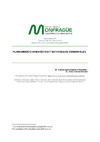Identificador persistente para citar o vincular este elemento:
https://accedacris.ulpgc.es/jspui/handle/10553/114466
| Campo DC | Valor | idioma |
|---|---|---|
| dc.contributor.author | Campesino Fernández, Antonio-José | en_US |
| dc.contributor.author | Jiménez Barrado, Victor | en_US |
| dc.date.accessioned | 2022-04-27T18:27:55Z | - |
| dc.date.available | 2022-04-27T18:27:55Z | - |
| dc.date.issued | 2017 | en_US |
| dc.identifier.issn | 2340-5457 | en_US |
| dc.identifier.uri | https://accedacris.ulpgc.es/handle/10553/114466 | - |
| dc.description.abstract | La insostenible tasa de urbanización europea, superior al 80% y disociada hoy de los procesos de industrialización, resulta imparable con huellas ecológicas crecientes, consumo de recursos, despilfarro energético e impactos ambientales producidos por los procesos de urbanización difusa y la construcción de masivas infraestructuras de transportes y comunicaciones. Urge revisar este modelo insostenible de urbanización, abordando la ordenación del territorio desde nuevas estrategias integradas de planificación física (territorial, urbanística, social y ambiental) y planificación económica, por este orden, sin supeditar las primeras a la segunda. Tarea que en España sigue siendo misión imposible por la cesión de competencias de ordenación territorial a las Comunidades Autónomas, por el desenfreno urbanístico-constructivo de la década prodigiosa y por la crisis crónica del planeamiento urbanístico, ajustado al territorio municipal y desajustado del urbanismo funcional. Desde la prepotencia urbana y el total desconocimiento de los municipios rurales se exportan de la ciudad al campo, sin anestesia, normas, planes y complejidad gestora. De cara a la revisión completa de las figuras de planeamiento, hay una pregunta clave sin respuesta ¿Qué planeamiento urbanístico debemos aplicar a mini-municipios regresivos, que no crecen demográficamente, pero sí superficialmente, cuando el planeamiento está diseñado sensu contrario para ciudades dinámicas y especulativas? | en_US |
| dc.description.abstract | The unsustainable rate of European urbanization, which is more than 80%, and dissociated today from industrialization processes, is unstoppable with increasing ecological footprints, resource consumption, energy waste and environmental impacts produced by diffused urbanization processes and the construction of massive transport infrastructure and communications It is urgent to review this unsustainable model of urbanization, approaching land-use planning from new integrated strategies of physical planning (territorial, urban, social and environmental) and economic planning, in this order, without subordinating the former to the second. This task in Spain is still impossible mission due to the assignment of territorial planning powers to the Autonomous Communities, the urbanconstructive development of the prodigious decade and the chronic crisis of urban planning, adjusted to the municipal territory and misfit of functional urbanism. From the urban arrogance and the total ignorance of the rural municipalities, norms, plans and management complexity are exported, without anesthesia, from the city to the countryside. For a complete revision of the planning figures, there is a key question unanswered ¿What urban planning should we apply to regressive mini-municipalities, without demographic but superficial growth, when planning is designed sensu contrario for dynamic and speculative cities? | en_US |
| dc.language | spa | en_US |
| dc.relation.ispartof | Monfragüe Desarrollo Resiliente | en_US |
| dc.source | Monfragüe Desarrollo Resiliente [2340-5457], Vo. VIII (2), (Abril 2017), p. 89-105 | en_US |
| dc.subject | 3329 Planificación urbana | en_US |
| dc.subject | 590208 Política del medio ambiente | en_US |
| dc.subject.other | Planificación urbanística | en_US |
| dc.subject.other | Estrategias ambientales | en_US |
| dc.subject.other | Pequeños municipios | en_US |
| dc.subject.other | Huellas ecológicas insostenibles | en_US |
| dc.subject.other | Urban planning | en_US |
| dc.subject.other | Environmental strategies | en_US |
| dc.subject.other | Small municipalities | en_US |
| dc.subject.other | Unsustainable ecological footprints | en_US |
| dc.title | Planeamiento urbanístico y estrategias ambientales | en_US |
| dc.type | info:eu-repo/semantics/article | en_US |
| dc.type | Article | en_US |
| dc.description.lastpage | 105 | en_US |
| dc.description.firstpage | 89 | en_US |
| dc.investigacion | Artes y Humanidades | en_US |
| dc.type2 | Artículo | en_US |
| dc.utils.revision | Sí | en_US |
| dc.identifier.ulpgc | No | en_US |
| dc.contributor.buulpgc | BU-HUM | en_US |
| item.grantfulltext | open | - |
| item.fulltext | Con texto completo | - |
| crisitem.author.dept | GIR IATEXT: Sociedades y Espacios Atlánticos | - |
| crisitem.author.dept | IU de Análisis y Aplicaciones Textuales | - |
| crisitem.author.dept | Departamento de Geografía | - |
| crisitem.author.orcid | 0000-0001-7064-7465 | - |
| crisitem.author.parentorg | IU de Análisis y Aplicaciones Textuales | - |
| crisitem.author.fullName | Jiménez Barrado, Victor | - |
| Colección: | Artículos | |
Visitas
91
actualizado el 12-jul-2025
Descargas
39
actualizado el 12-jul-2025
Google ScholarTM
Verifica
Comparte
Exporta metadatos
Los elementos en ULPGC accedaCRIS están protegidos por derechos de autor con todos los derechos reservados, a menos que se indique lo contrario.
